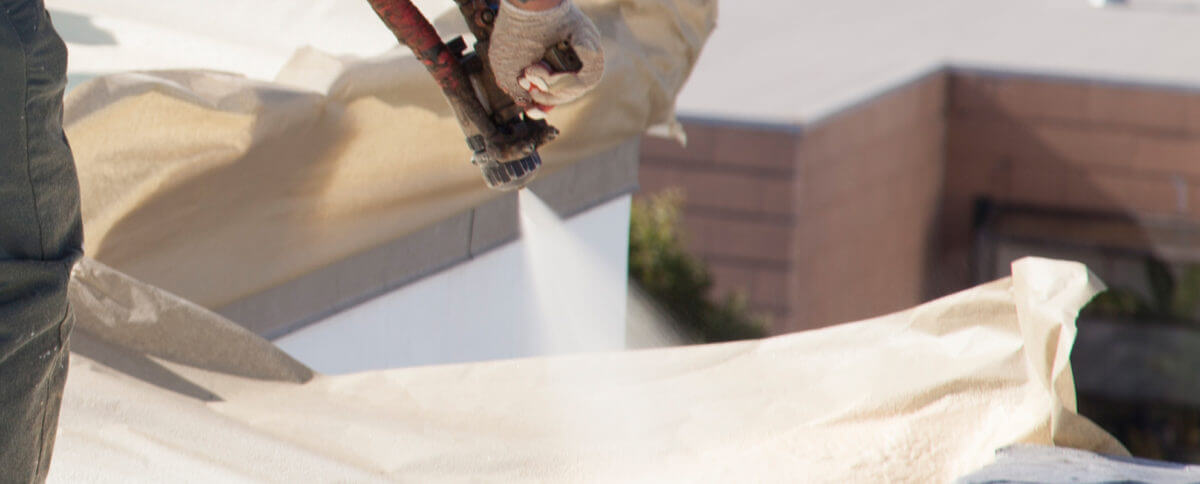What is a Building Envelope?
The term building envelope is used to describe the physical separator between the conditioned and unconditioned environment of a building, including the resistance to air, water, heat, light, and noise transfer. It takes into account all of the elements of the outer shell that maintain a dry, heated, or cooled indoor environment and facilitates its climate control.
The thermal envelope, or heat flow control layer, is part of a building envelope but may be in a different location such as in a ceiling. For example, an insulated attic floor is the primary thermal control layer between the inside of the house and the exterior while the entire roof, from the surface of the roofing material to the interior paint finish on the ceiling, makes up the building envelope.
Your Roof’s Insulation Natural Enemy
Your roof’s greatest enemy is, naturally, the “WEATHER”. For example, the heat and ultraviolet rays produced by the sun cause roofing materials to deteriorate over time. In fact, deterioration can occur faster on the sides facing west or south. Secondly, rainwater can get underneath roofing materials, work its way to the roof deck and cause the roof structure to rot. Extra moisture also encourages mildew and rot elsewhere in a building. Thirdly, high winds can lift the edges of roofing materials (including shingles) and force water and debris underneath them. Finally, melting snow often refreezes at a roof’s overhang, where the surface is cooler, forming an ice dam. This blocks proper drainage into the gutter. Water backs up under roofing materials and seeps into the interior. During the early melt stages, gutters and downspouts can be the first to fill with ice and be damaged beyond repair, or even torn off of a building.
Your Roof’s Insulation “Home-Made” Enemy
Apart from the weather, water, in the form of “MOISTURE”, can be found under almost all roofing materials, like tar and gravel, single ply, cap sheet, and IB roofing. This occurs because water vapors, in the form of indoor humidity during winter, travel to the cold underside of the roofing membrane. Water condenses on this cold surface and moisture and vapors build up in the foam boards, fiberglass, wood, and fiberboard under the membrane roof. Metal fasteners that secure foam boards under a roof, get very cold and attract water condensation. This moisture destroys the potential insulating properties of dry materials, aids dry rot and mold and decreases the lifespan of your building envelope.
Bay Area Homeowners’ Best Insulation Option
Considering that the majority of commercial and residential buildings in San Francisco and the Bay Area have low-slope roofs, it’s no surprise that a large percentage of all building-related problems are due to water intrusion. However, since the early 80s, Armstrong Foam Roofing has provided Bay Area homeowners with the best solution for flat roofing problems and one of the best insulation options still available today – SPF roofing insulation.
Benefits of Spray Polyurethane Foam (SPF) Roofing Systems as Insulation
You can end your roofing woes by installing a Spray Polyurethane Foam (SPF) system on the roof of your home or business. Since Armstrong’s SPF roofing system does not have seams or multiple layers, it forms a monolithic barrier that prevents air and water infiltration. There is also no expanding and contracting or separating that allows water and microbes to seep in and damage your roof and the insulation that protects you from the heat and cold of the external environment. What’s more, SPF roofing systems are referred to as “self-flashing” because they can be applied to verticle surfaces (e.g. parapet walls and roof penetration) in a contiguous manner and in the process eliminating seams and cold joints which are the main source of roof leaks. In fact, Armstrong’s SPF roofing system remains moisture-resistant even when the membrane coating is damaged. By controlling moisture infiltration, SPF roofing systems provide greater durability to buildings, since the main cause of building deterioration is moisture within the building envelope.
Another benefit of this system is its tenacious adhesion which was demonstrated in the most recent Florida hurricanes. Most importantly, though, SPF is considered to be “Green or Sustainable Building Material”(For more information about this issue, please also read our previous post on White Roofs). Inch-per-inch, it is the most energy-efficient roofing material available and provides excellent climate control within a building envelope. Consequently, we are able to reduce our consumption of fossil fuels and thereby reducing greenhouse gases released into our atmosphere. SPF roofing systems are also considered sustainable due to their proven longevity. According to the SPF Alliance, the authority on SPF material, an SPF roofing system requires minimal maintenance and if properly maintained, it can last over 50 years. In most cases, the maintenance simply involves only periodic recoating for decades of service. However, SPF roofing systems should be inspected semi-annually, in the Spring and again in the Fall. Additional inspections are also suggested following any event that might have caused damage to the system.
For more information about SPF roofing systems, please contact us today. Armstrong has installed more residential foam roofing than any other company in America! And we offer you the best, longest-lasting warranties available! Before you consider any other roofing system for your flat or low-sloped roof, let Armstrong show you why our Bay Area Foam roofing is your best investment for your home or business!

